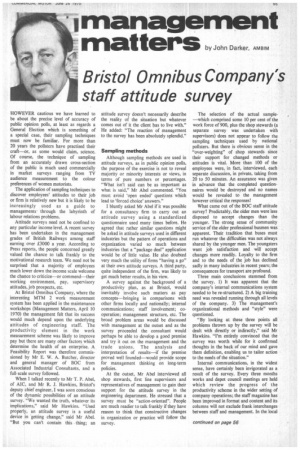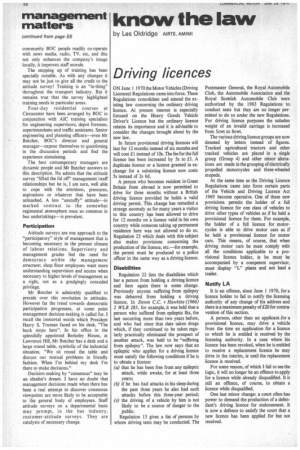Bristol Omnibus Company's Istaff attitude survey
Page 57

Page 58

If you've noticed an error in this article please click here to report it so we can fix it.
HOWEVER cautious we have learned to be about the precise level of accuracy of public opinion polls, at least as regards a General Election which is something of a special case, their sampling techniques must now be familiar. For more than 20 years the pollsters have practised their craft—or, as some would claim, science. Of course, the technique of sampling from an accurately drawn cross-section of the public is much used commercially in market surveys ranging from TV audience measurement to the colour preferences of women motorists.
The application of sampling techniques to discover employees' attitudes to their job or firm is relatively new but it is likely to be increasingly used as a guide to managements through the labyrinth of labour relations problems.
Attitude surveys need not be confined to any particular income level. A recent survey has been undertaken in the management grades of British Railways among staff earning over £.3000 a year. According to Press reports, the people concerned greatly valued the chance to talk frankly to the motivational research team. We need not be surprised that a majority of employees much lower down the income scale welcome the chance to criticize—or commend—their working environment, pay, supervisory attitudes, job prospects, etc.
At Bristol Omnibus Company, where the interesting MTM 2 work measurement system has been applied in the maintenance workshops (Management Matters, April 10 1970) the management felt that its success would much depend upon the underlying attitudes of engineering staff. The productivity element in the work measurement scheme was likely to improve pay but there are many other factors which determine the health of an enterprise. A Feasibility Report was therefore commissioned by Mr E. W. A. Butcher, director and general manager of BOC from Associated Industrial Consultants, and a full-scale survey followed.
When I talked recently to Mr T. P. Abel, of AIC, and Mr R. J. Hawkins, Bristol's deputy chief engineer, I was soon conscious of the dynamic possibilities of an attitude survey. "We wanted the truth, whatever its implications," said Mr Hawkins. "Used properly, an attitude survey is a useful device in 'getting change," said Mr Abel. "But you can't contain this thing; an attitude survey doesn't necessarily describe the reality of the situation but whatever comes out of it the client has to live with." He added: "The reaction of management to the survey has been absolutely splendid."
Sampling methods
Although sampling methods are used in attitude surveys, as in public opinion polls, the purpose of the exercise is not to reveal majority or minority interests or views, in terms of pure numbers or percentages. "What isn't said can be as important as what is said," Mr Abel commented. "You must avoid 'open ended' questions which lead to 'forced choice' answers."
I bluntly asked Mr Abel if it was possible for a consultancy firm to carry out an attitude survey using a standardized questionnaire used many times before. He agreed that rather similar questions might be asked in attitude surveys used in different industries but the pattern of operations and organization varied so much between industries that a "package deal" application would be of little value. He also doubted very much the utility of firms "having a go" at their own attitude surveys. A third party, quite independent of the firm, was likely to get much better results, in his view.
A survey against the background of a productivity plan, as at Bristol, would inevitably involve such matters as pay concepts—bringing in comparisons with other firms locally and nationally; internal communications; staff involvement; cooperation; management structure, etc. The broad problem areas would be discussed with management at the outset and as the survey proceeded the consultant would perhaps be able to develop a good premise and try it out on the management and the trade unions. The analysis and interpretation of results—if the premise proved well founded—would provide scope for management thinking on long-term policies.
At the outset, Mr Abel interviewed all shop stewards, first line supervisors and representatives of management to gain their support for the attitude survey in the engineering department. He stressed that a survey must be "action-oriented". People are much readier to talk frankly if they have reason to think that constructive changes in organization or practice will follow the survey. The selection of the actual sample-which comprised some 10 per cent of the work force of 900, plus the shop stewards (a separate survey was undertaken with supervisors) does not appear to follow the sampling techniques used by national pollsters. But there is obvious sense in the "over-weighting" of shop stewards since their support for changed methods or attitudes is vital. More than 100 of the employees were, in fact, interviewed, each separate discussion, in private, taking from 20 to 50 minutes. An assurance was given in advance that the completed questionnaires would be destroyed and no names would be revealed to the management however critical the responses!
What came out of the BOC staff attitude survey? Predictably, the older men were less disposed to accept changes than the younger. The strong sense of community service of the older professional busmen was apparent. Their tradition that buses must run whatever the difficulties was not always shared by the younger men. The youngsters want job satisfaction and will accept changes more readily. Loyalty to the firm and to the needs of the job has declined sadly in many industries in recent years; the consequences for transport are profound.
Three main conclusions stemmed from the survey. I) It was apparent that the company's internal communications system needed to be re-structured. 2) A big training need was revealed running through all levels of the company. 3) The management's organizational methods and "style" were questioned.
"By looking at these three points all problems thrown up by the survey will be dealt with directly or indirectly," said Mr Hawkins. "I'm entirely convinced that the survey was worth while for it confirmed thoughts in the back of our mind and gave them definition, enabling us to tailor action to the needs of the situation."
Internal communications, in the widest sense, have certainly been invigorated as a result of the survey. Every three months works and depot council meetings are held which review the progress of the productivity scheme in the wider setting of company operations; the staff magazine has been improved in format and content and its columns will not exclude frank interchanges between staff and management. In the local community BOC people readily co-operate with news media, radio, TV, etc, and this not only enhances the company's image locally, it improves stall morale.
The stepping up of training has been specially notable. As with any changes it may not be just to give all the credit to the attitude survey! Training is an "in-thing" throughout the transport industry. But it remains true that the survey highlighted training needs in particular areas.
Four-day residential courses at Cirencester have been arranged by BOC in conjunction with AIC training specialists for engineering supervisors, depot foremen, superintendents and traffic assistants. Senior engineering and planning officers—even Mr Butcher, BOC's director and general manager—expose themselves to questioning in the discussion periods and find the experience stimulating.
The best contemporary managers are dynamic people and Mr Butcher answers to this description. He admits that the attitude survey "lifted the lid off" management /staff relationships but he is, I am sure, well able to cope with the emotions, pressures, aspirations or whatever that have been unleashed. A less "unstuffy" attitude—in marked contrast to the somewhat regimental atmosphere once so common in bus undertakings—is prevalent.
Participation Attitude surveys are one approach to the "participatory" style of management that is becoming necessary in the present climate of labour relations. Supervisory and management grades feel the need for democracy within the management structure; shop floor employees want more understanding supervision and access when necessary to higher levels of management as a right, not as a grudgingly conceded privilege.
Mr Butcher is admirably qualified to preside over this revolution in attitudes. However far the trend towards democratic participation progresses, at some point management decision-making is called for. I recall the immortal words which President Harry S. Truman faced on his desk, "The buck stops here". In his office in the splendidly appointed Berkeley House, at Lawrence Hill, Mr Butcher has a desk and a large round table, symbolic of the industrial situation. "We sit round the table and discuss our mutual problems in friendly fashion. When I'm behind my desk I'm there to make decisions."
Decision-making by "consensus" may be an idealist's dream. I have no doubt that management decisions made when there has been a real attempt to discover consensus viewpoints are more likely to be acceptable to the general body of employees. Staff attitude surveys on a departmental basis may prompt, in the bus industry, customer-attitude surveys. They are catalysts of necessary change.






















































































































